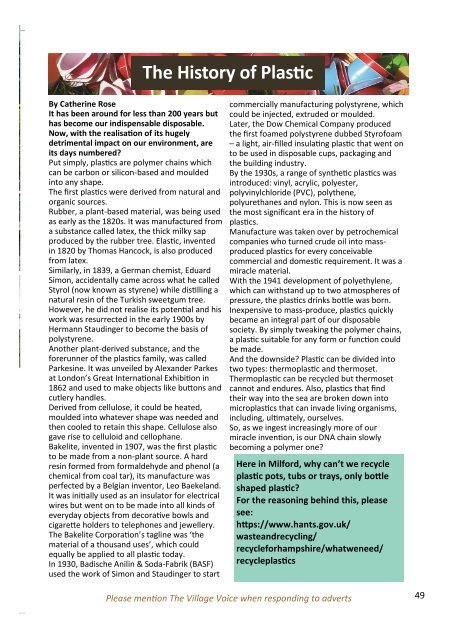The Village Voice Feb/Mar 2019
Community magazine
Community magazine
You also want an ePaper? Increase the reach of your titles
YUMPU automatically turns print PDFs into web optimized ePapers that Google loves.
By Catherine Rose<br />
It has been around for less than 200 years but<br />
has become our indispensable disposable.<br />
Now, with the realisation of its hugely<br />
detrimental impact on our environment, are<br />
its days numbered?<br />
Put simply, plastics are polymer chains which<br />
can be carbon or silicon-based and moulded<br />
into any shape.<br />
<strong>The</strong> first plastics were derived from natural and<br />
organic sources.<br />
Rubber, a plant-based material, was being used<br />
as early as the 1820s. It was manufactured from<br />
a substance called latex, the thick milky sap<br />
produced by the rubber tree. Elastic, invented<br />
in 1820 by Thomas Hancock, is also produced<br />
from latex.<br />
Similarly, in 1839, a German chemist, Eduard<br />
Simon, accidentally came across what he called<br />
Styrol (now known as styrene) while distilling a<br />
natural resin of the Turkish sweetgum tree.<br />
However, he did not realise its potential and his<br />
work was resurrected in the early 1900s by<br />
Hermann Staudinger to become the basis of<br />
polystyrene.<br />
Another plant-derived substance, and the<br />
forerunner of the plastics family, was called<br />
Parkesine. It was unveiled by Alexander Parkes<br />
at London’s Great International Exhibition in<br />
1862 and used to make objects like buttons and<br />
cutlery handles.<br />
Derived from cellulose, it could be heated,<br />
moulded into whatever shape was needed and<br />
then cooled to retain this shape. Cellulose also<br />
gave rise to celluloid and cellophane.<br />
Bakelite, invented in 1907, was the first plastic<br />
to be made from a non-plant source. A hard<br />
resin formed from formaldehyde and phenol (a<br />
chemical from coal tar), its manufacture was<br />
perfected by a Belgian inventor, Leo Baekeland.<br />
It was initially used as an insulator for electrical<br />
wires but went on to be made into all kinds of<br />
everyday objects from decorative bowls and<br />
cigarette holders to telephones and jewellery.<br />
<strong>The</strong> Bakelite Corporation’s tagline was ‘the<br />
material of a thousand uses’, which could<br />
equally be applied to all plastic today.<br />
In 1930, Badische Anilin & Soda-Fabrik (BASF)<br />
used the work of Simon and Staudinger to start<br />
<strong>The</strong> History of Plastic<br />
commercially manufacturing polystyrene, which<br />
could be injected, extruded or moulded.<br />
Later, the Dow Chemical Company produced<br />
the first foamed polystyrene dubbed Styrofoam<br />
– a light, air-filled insulating plastic that went on<br />
to be used in disposable cups, packaging and<br />
the building industry.<br />
By the 1930s, a range of synthetic plastics was<br />
introduced: vinyl, acrylic, polyester,<br />
polyvinylchloride (PVC), polythene,<br />
polyurethanes and nylon. This is now seen as<br />
the most significant era in the history of<br />
plastics.<br />
Manufacture was taken over by petrochemical<br />
companies who turned crude oil into massproduced<br />
plastics for every conceivable<br />
commercial and domestic requirement. It was a<br />
miracle material.<br />
With the 1941 development of polyethylene,<br />
which can withstand up to two atmospheres of<br />
pressure, the plastics drinks bottle was born.<br />
Inexpensive to mass-produce, plastics quickly<br />
became an integral part of our disposable<br />
society. By simply tweaking the polymer chains,<br />
a plastic suitable for any form or function could<br />
be made.<br />
And the downside? Plastic can be divided into<br />
two types: thermoplastic and thermoset.<br />
<strong>The</strong>rmoplastic can be recycled but thermoset<br />
cannot and endures. Also, plastics that find<br />
their way into the sea are broken down into<br />
microplastics that can invade living organisms,<br />
including, ultimately, ourselves.<br />
So, as we ingest increasingly more of our<br />
miracle invention, is our DNA chain slowly<br />
becoming a polymer one?<br />
Here in Milford, why can’t we recycle<br />
plastic pots, tubs or trays, only bottle<br />
shaped plastic?<br />
For the reasoning behind this, please<br />
see:<br />
https://www.hants.gov.uk/<br />
wasteandrecycling/<br />
recycleforhampshire/whatweneed/<br />
recycleplastics<br />
Please mention <strong>The</strong> <strong>Village</strong> <strong>Voice</strong> when responding to adverts<br />
49


















